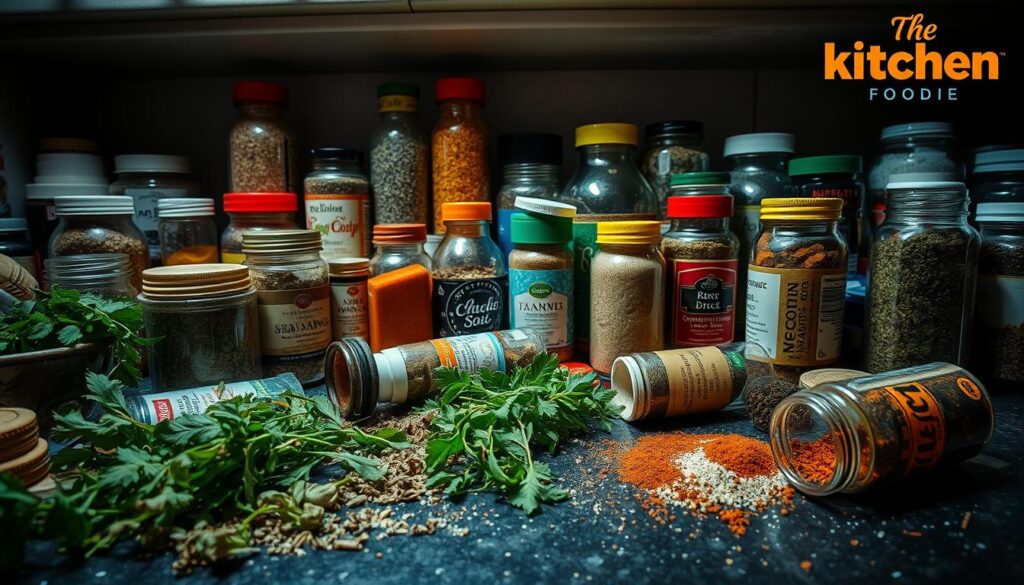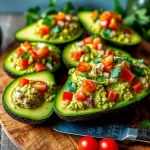Every kitchen has hidden gems: herbs and spices. They add flavor and are full of antioxidants and nutrients. At ComfortFoodCook, we think cookbook recipes are best when they mix bold flavors with health benefits. Imagine dishes that combine garlic’s heart health with turmeric’s anti-inflammatory powers.
Busy cooks need meals that are easy and healthy. Herbs like basil and oregano make meals nutritious. Even a little cinnamon can help control blood sugar in healthy cookbook recipes.
Let’s explore these secrets together. We’ll learn how to mix taste and wellness. Turn your spice rack into a tool for better health and flavor.
The Magic of Herbs and Spices in Home Cooking
Herbs and spices are nature’s flavor wonders. Herbs come from leaves, like basil or cilantro. Spices come from seeds, roots, or bark, like cinnamon or cumin. Both add flavor without extra work.
Lakeshore Shallot & Herb Seasoning is a great example. It’s a mix of scallions and peppercorns that makes dishes better. Even a little saffron can turn plain rice into a golden, aromatic side.
Begin with simple steps: fresh basil makes tomato sauce pop, while dried oregano boosts slow-cooked soups. Our favorite recipes show how a bit of rosemary in roasted veggies or smoked paprika in chili can make meals stand out. Even busy cooks can whip up cilantro-lime chicken in just five minutes, yet it tastes like a gourmet dish.
Try new things: add thyme to roasted potatoes or mix cumin into chili powder for taco seasoning. With these tips, your meals become flavorful journeys. Check out our easy recipes to see how small ingredient changes can make dishes special. Your spice rack is all you need to make meals as good as restaurants.
Health Benefits Hidden in Your Spice Rack
Your spice rack is more than just for flavor. It’s a key to better health. Herbs and spices like turmeric and cinnamon have compounds that help your body.
Turmeric’s curcumin fights inflammation and may protect against chronic diseases. Over 6,000 studies show it reduces arthritis pain and boosts brain function. Cinnamon helps control blood sugar and supports heart health.
Turmeric supplements can increase bone density by 7% in older adults. Garlic lowers blood pressure and inflammation. Ginger helps with nausea.
Even a little goes a long way. Two teaspoons of cloves give over 60% of daily manganese, boosting immunity. Oregano’s beta-caryophyllene is good for joints and heart health.
When cooking healthy meals, use these ingredients. Cumin’s antioxidants may reverse bone loss, and sage’s antibacterial properties add extra protection. Try adding them to your meals for a flavor and health boost. Small changes can make a big difference. Let’s make our meals more nutritious with what we already have.
Essential Herbs and Spices Every Home Cook Should Own
We suggest starting with a few key ingredients that are great for popular cookbook recipes. Black pepper is a must-have, packed with antioxidants. It aids digestion and adds a nice warmth to many dishes. Cinnamon is perfect for sweet treats and savory stews, while cumin brings a rich flavor to Mexican and Indian dishes.
Turmeric is a golden spice that boosts the health benefits of your meals. It’s great in rice dishes and roasted vegetables. These spices are the foundation of a well-stocked kitchen.
Garlic powder and onion powder are quick fixes for weeknight meals, adding a lot of flavor without the prep work. Bay leaves add a subtle depth to soups and stews. Dried basil is a go-to for Italian dishes. And don’t forget whole nutmeg for a fresh aroma in sauces and pastas.
For a smoky flavor, try toasted cumin seeds in your salads. Store your spices in airtight containers, away from sunlight. Replace ground spices every month to keep the flavors strong. These basics will help you cook up a storm without cluttering your pantry.
Using these spices with fresh herbs like cilantro or parsley can open up a world of flavors. And remember, proper storage keeps your spices potent for all your favorite dishes.
Techniques for Maximizing Flavor in Your Cookbook Recipes
Timing is key when using herbs and spices. Start by knowing when to add them. Hard herbs like rosemary and thyme do well in long simmering. But delicate herbs like basil or cilantro are best added at the end.
Our favorite cookbook recipes from Maximum Flavor by Alex Talbot and Aki Kamozawa show how technique can elevate a dish. They offer quick tips for busy people, like frozen herb pastes or fast spice blends.
Here are some ways to boost flavor:
– Bloom spices: Sauté cumin or coriander in oil before adding other ingredients to release 20% more aroma.
– Toast whole spices: Dry-roast cardamom or fennel seeds before grinding to amplify their taste.
– Infuse oils: Simmer rosemary in olive oil for 20 minutes, then strain for a ready-to use base in pasta or soups.
– Freeze smart: Blend parsley, garlic, and olive oil into a paste, portion into ice cube trays, and freeze for quick use.
Even small steps can make a big difference. Adding a pinch of sugar to vegetables before roasting or deglazing pans to capture fond can enhance dishes. The authors’ quick and delicious recipes show that great flavor doesn’t need extra time. It just needs smart choices.
Around the World with Herbs and Spices
Herbs and spices are key to every culture’s taste. From India’s garam masala to the Middle East’s za’atar, they shape global cuisines. Each blend adds a unique flavor to meals, telling stories of tradition and taste.
You don’t need exotic markets to make authentic dishes. Our guide helps you find ingredients easily, with substitutes for hard-to-find items. For example, mix cumin, coriander, and cinnamon to get close to garam masala. These tips let you make popular cookbook recipes at home.
Need inspiration? Check out “Savor The World Global Bites”. It has 24 recipes that celebrate different cultures with these iconic blends.
Herbs and spices are more than just flavor. They’re also good for you. 68% of people choose them for health reasons. Since 2020, home cooking with them has grown by 40%. The global spice market is expected to reach $25.5 billion by 2028.
Try out cultural staples like Chinese five-spice or Mexican chili blends. Start with small amounts—add za’atar to hummus or sprinkle paprika on roasted veggies. Every dish opens a door to new cuisines. By mastering these basics, you’ll enjoy the best cookbook recipes without losing authenticity.
Family-Friendly Recipes Featuring Herbs and Spices
Adding herbs and spices to meals can make picky eaters love veggies. A study by the University of Maryland showed herbs can increase veggie eating by 18.2% in teens. Our family-friendly recipes make cooking fun for kids and help them develop a taste for flavors.
Try our easy recipes like Herbed Feta Dip, a quick 25-minute appetizer. Kids can help mix it. Serve it with veggies or whole-grain crackers for a healthy snack. For a main dish, our Spiced Grilled Chicken (35 minutes) with cilantro lime butter is a hit. You can adjust the spice to fit your family’s taste.
Get everyone involved in the kitchen! Kids can crush garlic, sprinkle dried oregano, or mix cinnamon into pancake batter. Our Chicken Noodle Soup (30 minutes) is perfect for toddlers and adults alike. Slow Cooker Tacos (25 mins) with cumin and chili powder are easy to make and let everyone add their favorite toppings.
Our family-friendly recipes are both healthy and tasty. Cheesy Mashed Potatoes (1 hour 20 mins) mix dill and garlic, while Basil Chicken Sandwiches (15 mins) are a quick and flavorful lunch. Even desserts like Cinnamon-Basil Ice Cream (45 mins) add flavor without sugar.
Check out our collection of over 50 meals for busy families. Each recipe shows how herbs like basil or spices like cumin can make meals exciting. Let’s make mealtime an adventure where everyone finds new favorites!
Storing and Preserving Your Herbal Ingredients
Keeping herbs and spices fresh is key for healthy recipes. We’ll look at easy ways to keep them fresh. Start by separating soft herbs like cilantro from hard ones like rosemary. Soft herbs do well in a jar of water, like basil stems in a glass.
For longer storage, wrap damp paper towels around parsley or dill. Then, seal it in a plastic bag.
Freezing is great for bulk herbs. Chop cilantro or mint, pack into ice cube trays, and cover with olive oil or water. This keeps their flavor for quick recipes all year. Dried spices need airtight containers, away from heat and light. Move them from original bags into glass jars with tight lids.
Whole spices like peppercorns or cumin seeds last up to four years in cool, dry places. Test spice freshness by smelling it. If it’s faint, it’s time to get more. Dried herbs should be used within two years for the best taste.
Use dry measuring spoons to avoid moisture. Never dip them directly into spice jars. Basil prefers room temperature over the fridge. Store soft herbs like parsley in the fridge’s crisper drawer, changing water every few days.
Follow these tips to reduce food waste and make meal prep easier. Properly stored herbs help you make vibrant meals without last-minute trips. Need help picking quality spices? Learn why whole spices beat pre-ground for lasting flavor. With these methods, your pantry will always have fresh ingredients for any recipe.
Growing Your Own Culinary Herbs at Home
Starting a home herb garden adds fresh flavor to your kitchen and saves money. Fresh herbs like basil, mint, and chives are at their best when picked young. For kitchen herb success, start with easy varieties that fit your climate. Chives do well in containers, thriving in USDA zones 3-11. Mint, on the other hand, needs pots to control its spread.
Outdoor herbs like Greek oregano need lots of sunlight to taste their best. Rosemary likes well-drained soil and can grow quite tall, so give it room. Thyme grows better from plants and attracts pollinators. Harvesting often keeps leaves flavorful. Drying herbs like thyme properly helps keep their aroma for winter.
Use these fresh herbs to make weeknight dinner recipes taste better. Add basil to pasta dishes or infuse oils with parsley for quick sauces. Our guide shows how homegrown herbs can make healthy cookbook recipes even better. Container gardens are great for small spaces, needing 6-8 hours of sunlight daily.
Start with 3-5 herbs to get the hang of it. Mix fresh herbs into everyday meals for extra nutrition. With the right care, you’ll have a constant supply of fresh herbs for your favorite dishes.
Common Mistakes When Cooking with Herbs and Spices
Timing is crucial when adding herbs and spices. Dried herbs need time to blend well, so add them early. Fresh herbs lose flavor when boiled, so add them last. Rushing this step can make meals taste flat, which is common in easy recipes.
Using too much of any spice is another mistake. Start with a small amount and adjust as needed. Too much paprika can overwhelm dishes, even simple weeknight meals.

Choosing the right flavors is important to avoid clashing tastes. Basil is great in tomato dishes but might not work with spicy stir-fries. Always balance flavors with acidity, salt, and sweetness.
If a dish is too salty, adding something bland like rice or yogurt can help. For quick weeknight dinners, prepare spice blends in advance to avoid mistakes.
Keep spices fresh by storing them in a cool, dark place. Fresh herbs should be used within a week for the best flavor. Remember, tasting as you cook is essential. Small changes can make a big difference. With these tips, even busy cooks can make delicious weeknight dinners without stress.
Best Cookbook Recipes for Herb and Spice Enthusiasts
Discover the best cookbook recipes that focus on herbs and spices. Whether you’re exploring global flavors or creating new blends, top books like The Food Lab and Ottolenghi Flavor are great. They offer dishes that highlight the beauty of aromatic ingredients. Here are some of our favorites:
- Fiery Ferments: 70+ recipes that mix chilies and herbs, great for those who love bold flavors.
- Mastering Spice: Each recipe has 5 variations, making it easy to adjust flavors to your liking.
- Herbs and Spices: The Cook’s Reference: A comprehensive guide to over 50 seasonings, with tips on how to pair them.
- The Minimalist Kitchen: Offers simple cooking methods for busy people, focusing on fresh herbs like basil and cilantro.
Popular recipes often use regional spices to add depth to dishes. For example, Sourdough by Sarah Owens uses simple ingredients for bread. Vegetables Illustrated shows 30 broccoli recipes, each enhanced with herbs like rosemary and thyme.
Organize your cookbooks by flavor type (savory, sweet, smoky) to use spices better. Try Franklin Barbecue’s rubs for meats or Anarchy of Chillies for spicy dishes. For help balancing flavors, check out our guide on seasoning basics—don’t be afraid of seasoning your.
These resources make herbs and spices a part of your daily cooking. Whether you’re making classic dishes or creating new ones, these cookbooks help you make meals full of authentic, healthy flavors.
Elevate Your Everyday Cooking with Nature’s Flavor Enhancers
Everyday meals can become family-friendly recipes with the right spice blends. Try adding a pinch of cumin to rice or a squeeze of lemon zest to veggies. These tweaks can make meals more exciting for everyone.
Make your own spice mixes with common ingredients like garlic powder or smoked paprika. A $7 jar of Laoganma Chili Crisp can spice up eggs or popcorn. For $6, Coconut Secret Coconut Aminos can brighten stir-fries. Even a $9 Tajín Clásico can add a Mexican twist to watermelon or tacos. These items help make quick and delicious recipes in no time.
Play with pantry staples to create tasty dishes. Mix cumin, coriander, and garlic powder for a versatile rub. Toss roasted veggies with lemon juice and oregano for a burst of flavor. Herbs like cilantro for tacos or basil in pasta are also great. They add flavor without costing much.
Learn from spice traditions. A $26 pack of Better Than Bouillon can enhance soups. For $8, nutritional yeast can give pasta a cheesy taste. These tips are in line with today’s trend of choosing sustainable food. By using these methods, you can make meals that taste like they were made from scratch, like lentil soup or herb-crusted salmon with lemon.
Source Links
- https://www.lauramali.com/health-benefits-of-cooking-with-herbs-and-spices/
- https://to-table.com/blogs/recipes/herbs-and-spices-the-definitive-guide?srsltid=AfmBOoqgAw0f4k4WmL1R0GWws2VGREbKEAWqdqOYQELHIfPI-mJX8lS6
- https://www.thespicehouse.com/blogs/recipes?srsltid=AfmBOoo7GLQFQUzMRCuyGAYiT0-jNgX3lkxYGs0xLfC6o9BBF_jIUvSd
- https://www.tasteofhome.com/collection/recipes-with-fresh-herbs/?srsltid=AfmBOorDtDDMT3KG54zzMncm2LPXb3OYtWC8_v_MZxogQLPTnrVzFqlh
- https://www.danielplan.com/9-herbs-spices-that-fight-inflammation/
- https://food4healthybones.com/blog/spice-up-your-bones/
- https://zestfulkitchen.com/10-essential-spices-and-dried-herbs-for-every-home-cook/
- https://www.lauramali.com/12-must-have-spices-and-herbs/
- https://atkfamily.com/10-simple-tips-to-make-food-taste-better/
- https://www.amazingfoodmadeeasy.com/info/modernist-books/more/maximum-flavor-recipes-that-will-change-the-way-you
- https://www.worldofbooks.com/en-gb/collections/delicious-cookbook-recipes-using-the-best-spices-and-herbs-from-around-the-world-book-series
- https://feelgoodfoodie.net/recipe/roasted-chicken-garlic-herbs/
- https://www.yummytoddlerfood.com/healthy-family-meals/
- https://www.tasteofhome.com/collection/recipes-with-fresh-herbs/?srsltid=AfmBOoo9-A9YrG5ogO7XZmddvgOShWLBem2paDfCK0tVPVOlEXScrGib
- https://www.allrecipes.com/article/10-herb-and-spice-storage-tips/
- https://www.themediterraneandish.com/how-to-store-fresh-herbs/
- https://mountainvalleygrowers.com/organic-plants/kitchen-herb-garden/
- https://wellnessmama.com/natural-home/growing-herbs/
- https://www.gettystewart.com/everyday-cooking-with-herbs/
- https://www.smh.com.au/goodfood/11-common-mistakes-home-cooks-make-and-how-to-avoid-them-20200820-h1q56n.html
- https://foodal.com/knowledge/how-to/common-cooking-mistakes/
- https://www.self.com/story/mistakes-you-might-be-making-seasoning-food
- https://nyamwithny.com/7-spicy-food-cookbooks/
- https://chrislovesjulia.com/10-essential-cookbooks-chriss-favorites/
- https://www.self.com/story/ingredients-for-big-flavor-fast
- https://foodandnutrition.com/recipes/













